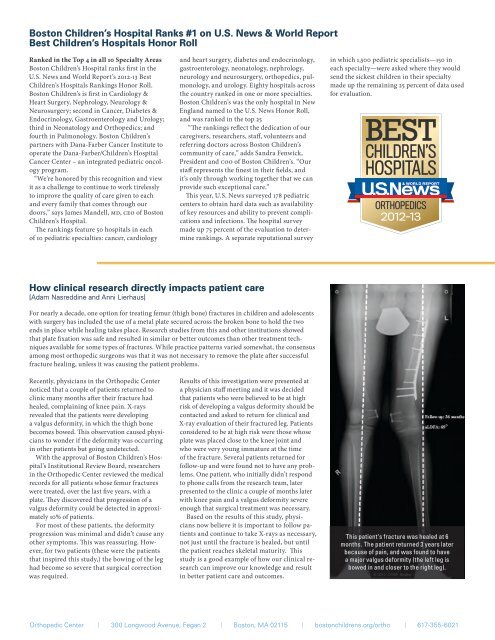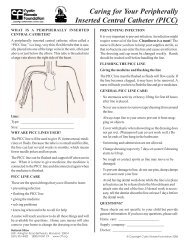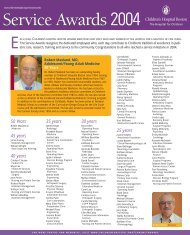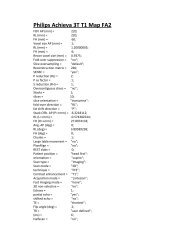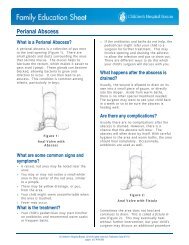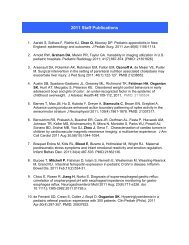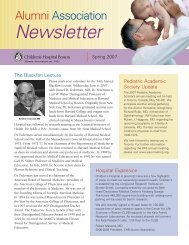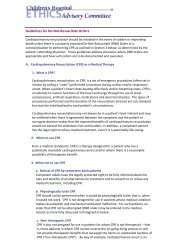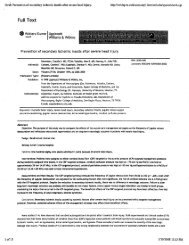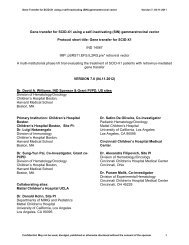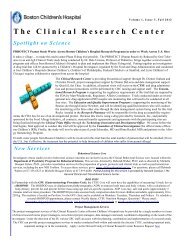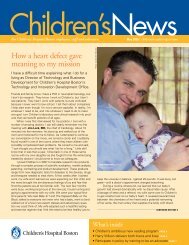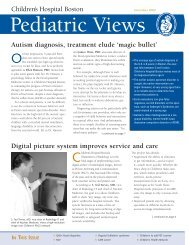Ortho Times Vol 24 - Children's Hospital Boston
Ortho Times Vol 24 - Children's Hospital Boston
Ortho Times Vol 24 - Children's Hospital Boston
Create successful ePaper yourself
Turn your PDF publications into a flip-book with our unique Google optimized e-Paper software.
<strong>Boston</strong> Children’s <strong>Hospital</strong> Ranks #1 on U.S. News & World Report<br />
Best Children’s <strong>Hospital</strong>s Honor Roll<br />
Ranked in the Top 4 in all 10 Specialty Areas<br />
<strong>Boston</strong> Children’s <strong>Hospital</strong> ranks first in the<br />
U.S. News and World Report’s 2012-13 Best<br />
Children’s <strong>Hospital</strong>s Rankings Honor Roll.<br />
<strong>Boston</strong> Children’s is first in Cardiology &<br />
Heart Surgery, Nephrology, Neurology &<br />
Neurosurgery; second in Cancer, Diabetes &<br />
Endocrinology, Gastroenterology and Urology;<br />
third in Neonatology and <strong>Ortho</strong>pedics; and<br />
fourth in Pulmonology. <strong>Boston</strong> Children’s<br />
partners with Dana-Farber Cancer Institute to<br />
operate the Dana-Farber/Children’s <strong>Hospital</strong><br />
Cancer Center – an integrated pediatric oncology<br />
program.<br />
“We’re honored by this recognition and view<br />
it as a challenge to continue to work tirelessly<br />
to improve the quality of care given to each<br />
and every family that comes through our<br />
doors,” says James Mandell, MD, CEO of <strong>Boston</strong><br />
Children’s <strong>Hospital</strong>.<br />
The rankings feature 50 hospitals in each<br />
of 10 pediatric specialties: cancer, cardiology<br />
How clinical research directly impacts patient care<br />
[Adam Nasreddine and Anni Lierhaus]<br />
For nearly a decade, one option for treating femur (thigh bone) fractures in children and adolescents<br />
with surgery has included the use of a metal plate secured across the broken bone to hold the two<br />
ends in place while healing takes place. Research studies from this and other institutions showed<br />
that plate fixation was safe and resulted in similar or better outcomes than other treatment techniques<br />
available for some types of fractures. While practice patterns varied somewhat, the consensus<br />
among most orthopedic surgeons was that it was not necessary to remove the plate after successful<br />
fracture healing, unless it was causing the patient problems.<br />
Recently, physicians in the <strong>Ortho</strong>pedic Center<br />
noticed that a couple of patients returned to<br />
clinic many months after their fracture had<br />
healed, complaining of knee pain. X-rays<br />
revealed that the patients were developing<br />
a valgus deformity, in which the thigh bone<br />
becomes bowed. This observation caused physicians<br />
to wonder if the deformity was occurring<br />
in other patients but going undetected.<br />
With the approval of <strong>Boston</strong> Children’s <strong>Hospital</strong>’s<br />
Institutional Review Board, researchers<br />
in the <strong>Ortho</strong>pedic Center reviewed the medical<br />
records for all patients whose femur fractures<br />
were treated, over the last five years, with a<br />
plate. They discovered that progression of a<br />
valgus deformity could be detected in approximately<br />
10% of patients.<br />
For most of these patients, the deformity<br />
progression was minimal and didn’t cause any<br />
other symptoms. This was reassuring. However,<br />
for two patients (these were the patients<br />
that inspired this study,) the bowing of the leg<br />
had become so severe that surgical correction<br />
was required.<br />
and heart surgery, diabetes and endocrinology,<br />
gastroenterology, neonatology, nephrology,<br />
neurology and neurosurgery, orthopedics, pulmonology,<br />
and urology. Eighty hospitals across<br />
the country ranked in one or more specialties.<br />
<strong>Boston</strong> Children’s was the only hospital in New<br />
England named to the U.S. News Honor Roll,<br />
and was ranked in the top 25<br />
“The rankings reflect the dedication of our<br />
caregivers, researchers, staff, volunteers and<br />
referring doctors across <strong>Boston</strong> Children’s<br />
community of care,” adds Sandra Fenwick,<br />
President and COO of <strong>Boston</strong> Children’s. “Our<br />
staff represents the finest in their fields, and<br />
it’s only through working together that we can<br />
provide such exceptional care.”<br />
This year, U.S. News surveyed 178 pediatric<br />
centers to obtain hard data such as availability<br />
of key resources and ability to prevent complications<br />
and infections. The hospital survey<br />
made up 75 percent of the evaluation to determine<br />
rankings. A separate reputational survey<br />
Results of this investigation were presented at<br />
a physician staff meeting and it was decided<br />
that patients who were believed to be at high<br />
risk of developing a valgus deformity should be<br />
contacted and asked to return for clinical and<br />
X-ray evaluation of their fractured leg. Patients<br />
considered to be at high risk were those whose<br />
plate was placed close to the knee joint and<br />
who were very young immature at the time<br />
of the fracture. Several patients returned for<br />
follow-up and were found not to have any problems.<br />
One patient, who initially didn’t respond<br />
to phone calls from the research team, later<br />
presented to the clinic a couple of months later<br />
with knee pain and a valgus deformity severe<br />
enough that surgical treatment was necessary.<br />
Based on the results of this study, physicians<br />
now believe it is important to follow patients<br />
and continue to take X-rays as necessary,<br />
not just until the fracture is healed, but until<br />
the patient reaches skeletal maturity. This<br />
study is a good example of how our clinical research<br />
can improve our knowledge and result<br />
in better patient care and outcomes.<br />
in which 1,500 pediatric specialists—150 in<br />
each specialty—were asked where they would<br />
send the sickest children in their specialty<br />
made up the remaining 25 percent of data used<br />
for evaluation.<br />
This patient’s fracture was healed at 6<br />
months. The patient returned 3 years later<br />
because of pain, and was found to have<br />
a major valgus deformity (the left leg is<br />
bowed in and closer to the right leg).<br />
<strong>Ortho</strong>pedic Center | 300 Longwood Avenue, Fegan 2 | <strong>Boston</strong>, MA 02115 | bostonchildrens.org/ortho | 617-355-6021


